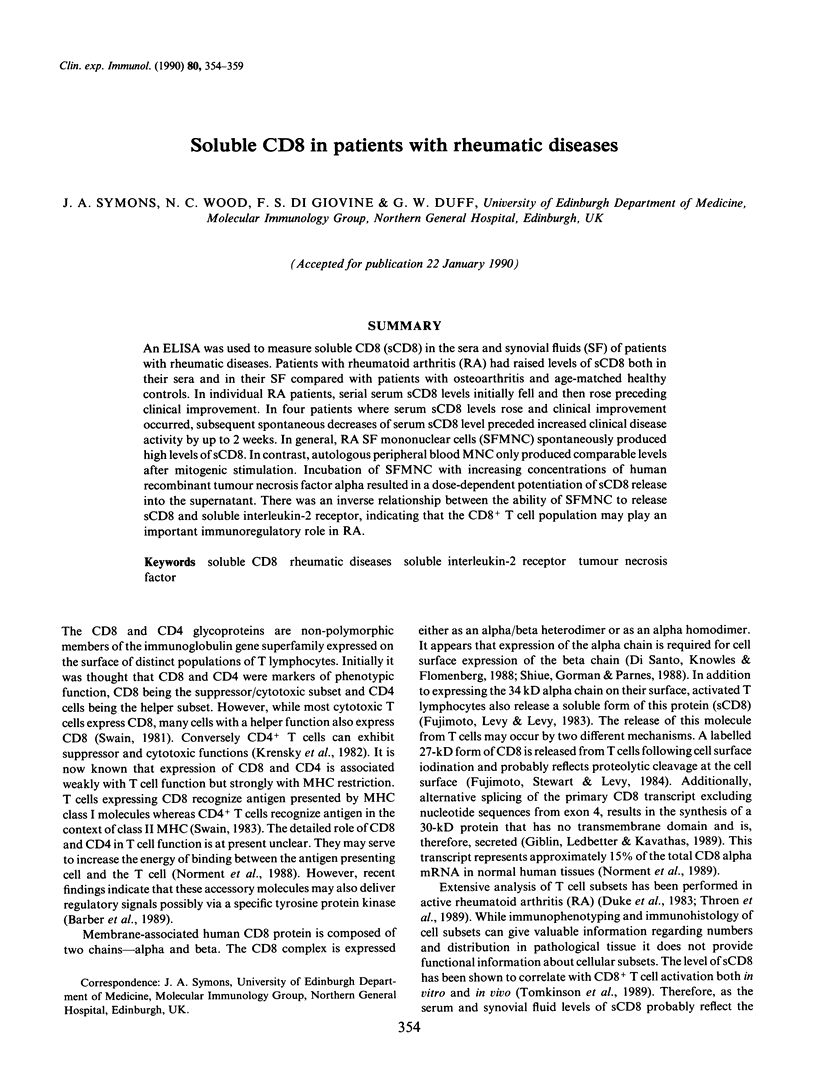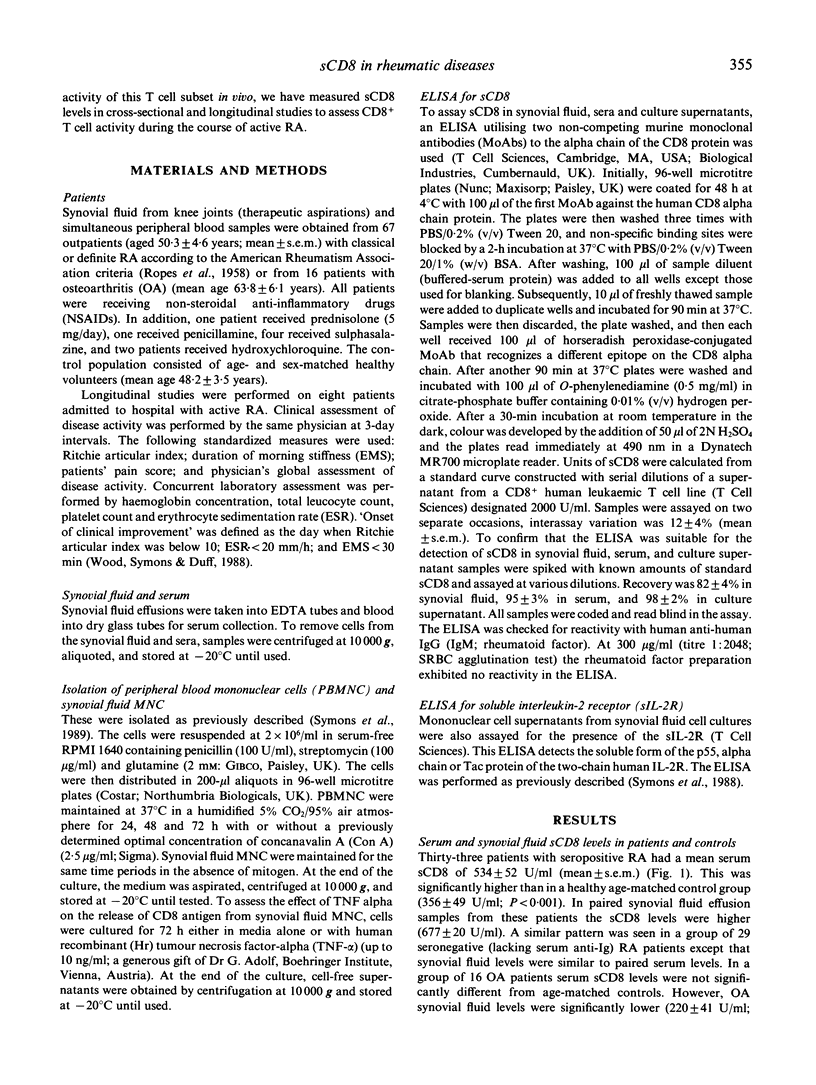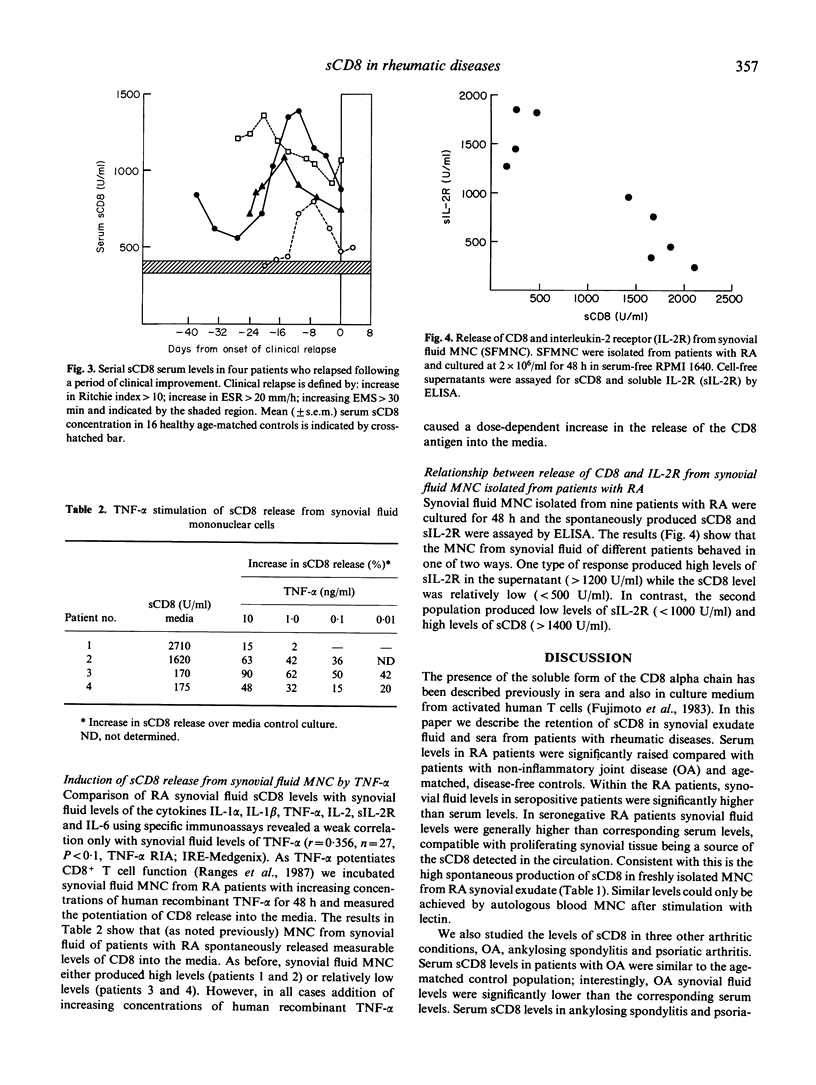Abstract
An ELISA was used to measure soluble CD8 (sCD8) in the sera and synovial fluids (SF) of patients with rheumatic diseases. Patients with rheumatoid arthritis (RA) had raised levels of sCD8 both in their sera and in their SF compared with patients with osteoarthritis and age-matched healthy controls. In individual RA patients, serial serum sCD8 levels initially fell and then rose preceding clinical improvement. In four patients where serum sCD8 levels rose and clinical improvement occurred, subsequent spontaneous decreases of serum sCD8 level preceded increased clinical disease activity by up to 2 weeks. In general, RA SF mononuclear cells (SFMNC) spontaneously produced high levels of sCD8. In contrast, autologous peripheral blood MNC only produced comparable levels after mitogenic stimulation. Incubation of SFMNC with increasing concentrations of human recombinant tumour necrosis factor alpha resulted in a dose-dependent potentiation of sCD8 release into the supernatant. There was an inverse relationship between the ability of SFMNC to release sCD8 and soluble interleukin-2 receptor, indicating that the CD8+ T cell population may play an important immunoregulatory role in RA.
Full text
PDF





Selected References
These references are in PubMed. This may not be the complete list of references from this article.
- Asher A. L., Mulé J. J., Rosenberg S. A. Recombinant human tumor necrosis factor mediates regression of a murine sarcoma in vivo via Lyt-2+ cells. Cancer Immunol Immunother. 1989;28(2):153–156. doi: 10.1007/BF00199117. [DOI] [PMC free article] [PubMed] [Google Scholar]
- Barber E. K., Dasgupta J. D., Schlossman S. F., Trevillyan J. M., Rudd C. E. The CD4 and CD8 antigens are coupled to a protein-tyrosine kinase (p56lck) that phosphorylates the CD3 complex. Proc Natl Acad Sci U S A. 1989 May;86(9):3277–3281. doi: 10.1073/pnas.86.9.3277. [DOI] [PMC free article] [PubMed] [Google Scholar]
- Di Giovine F. S., Nuki G., Duff G. W. Tumour necrosis factor in synovial exudates. Ann Rheum Dis. 1988 Sep;47(9):768–772. doi: 10.1136/ard.47.9.768. [DOI] [PMC free article] [PubMed] [Google Scholar]
- DiSanto J. P., Knowles R. W., Flomenberg N. The human Lyt-3 molecule requires CD8 for cell surface expression. EMBO J. 1988 Nov;7(11):3465–3470. doi: 10.1002/j.1460-2075.1988.tb03221.x. [DOI] [PMC free article] [PubMed] [Google Scholar]
- Duke O., Panayi G. S., Janossy G., Poulter L. W. An immunohistological analysis of lymphocyte subpopulations and their microenvironment in the synovial membranes of patients with rheumatoid arthritis using monoclonal antibodies. Clin Exp Immunol. 1982 Jul;49(1):22–30. [PMC free article] [PubMed] [Google Scholar]
- Duke O., Panayi G. S., Janossy G., Poulter L. W., Tidman N. Analysis of T cell subsets in the peripheral blood and synovial fluid of patients with rheumatoid arthritis by means of monoclonal antibodies. Ann Rheum Dis. 1983 Aug;42(4):357–361. doi: 10.1136/ard.42.4.357. [DOI] [PMC free article] [PubMed] [Google Scholar]
- Fujimoto J., Levy S., Levy R. Spontaneous release of the Leu-2 (T8) molecule from human T cells. J Exp Med. 1983 Sep 1;158(3):752–766. doi: 10.1084/jem.158.3.752. [DOI] [PMC free article] [PubMed] [Google Scholar]
- Fujimoto J., Stewart S. J., Levy R. Immunochemical analysis of the released Leu-2 (T8) molecule. J Exp Med. 1984 Jul 1;160(1):116–124. doi: 10.1084/jem.160.1.116. [DOI] [PMC free article] [PubMed] [Google Scholar]
- Giblin P., Ledbetter J. A., Kavathas P. A secreted form of the human lymphocyte cell surface molecule CD8 arises from alternative splicing. Proc Natl Acad Sci U S A. 1989 Feb;86(3):998–1002. doi: 10.1073/pnas.86.3.998. [DOI] [PMC free article] [PubMed] [Google Scholar]
- Klarnet J. P., Kern D. E., Dower S. K., Matis L. A., Cheever M. A., Greenberg P. D. Helper-independent CD8+ cytotoxic T lymphocytes express IL-1 receptors and require IL-1 for secretion of IL-2. J Immunol. 1989 Apr 1;142(7):2187–2191. [PubMed] [Google Scholar]
- Kondo N., Kondo S., Shimizu A., Honjo T., Hamuro J. A soluble 'anchorminus' interleukin 2 receptor suppresses in vitro interleukin 2-mediated immune responses. Immunol Lett. 1988 Dec;19(4):299–307. doi: 10.1016/0165-2478(88)90159-9. [DOI] [PubMed] [Google Scholar]
- Norment A. M., Littman D. R. A second subunit of CD8 is expressed in human T cells. EMBO J. 1988 Nov;7(11):3433–3439. doi: 10.1002/j.1460-2075.1988.tb03217.x. [DOI] [PMC free article] [PubMed] [Google Scholar]
- Norment A. M., Lonberg N., Lacy E., Littman D. R. Alternatively spliced mRNA encodes a secreted form of human CD8 alpha. Characterization of the human CD8 alpha gene. J Immunol. 1989 May 1;142(9):3312–3319. [PubMed] [Google Scholar]
- Norment A. M., Salter R. D., Parham P., Engelhard V. H., Littman D. R. Cell-cell adhesion mediated by CD8 and MHC class I molecules. Nature. 1988 Nov 3;336(6194):79–81. doi: 10.1038/336079a0. [DOI] [PubMed] [Google Scholar]
- Pui C. H., Ip S. H., Thompson E., Dodge R. K., Brown M., Wilimas J., Carrabis S., Kung P., Berard C. W., Crist W. M. Increased serum CD8 antigen level in childhood Hodgkin's disease relates to advanced stage and poor treatment outcome. Blood. 1989 Jan;73(1):209–213. [PubMed] [Google Scholar]
- ROPES M. W., BENNETT G. A., COBB S., JACOX R., JESSAR R. A. 1958 Revision of diagnostic criteria for rheumatoid arthritis. Bull Rheum Dis. 1958 Dec;9(4):175–176. [PubMed] [Google Scholar]
- Ranges G. E., Figari I. S., Espevik T., Palladino M. A., Jr Inhibition of cytotoxic T cell development by transforming growth factor beta and reversal by recombinant tumor necrosis factor alpha. J Exp Med. 1987 Oct 1;166(4):991–998. doi: 10.1084/jem.166.4.991. [DOI] [PMC free article] [PubMed] [Google Scholar]
- Shiue L., Gorman S. D., Parnes J. R. A second chain of human CD8 is expressed on peripheral blood lymphocytes. J Exp Med. 1988 Dec 1;168(6):1993–2005. doi: 10.1084/jem.168.6.1993. [DOI] [PMC free article] [PubMed] [Google Scholar]
- Swain S. L. Significance of Lyt phenotypes: Lyt2 antibodies block activities of T cells that recognize class 1 major histocompatibility complex antigens regardless of their function. Proc Natl Acad Sci U S A. 1981 Nov;78(11):7101–7105. doi: 10.1073/pnas.78.11.7101. [DOI] [PMC free article] [PubMed] [Google Scholar]
- Swain S. L. T cell subsets and the recognition of MHC class. Immunol Rev. 1983;74:129–142. doi: 10.1111/j.1600-065x.1983.tb01087.x. [DOI] [PubMed] [Google Scholar]
- Symons J. A., McDowell T. L., di Giovine F. S., Wood N. C., Capper S. J., Duff G. W. Interleukin 1 in rheumatoid arthritis: potentiation of immune responses within the joint. Lymphokine Res. 1989 Fall;8(3):365–372. [PubMed] [Google Scholar]
- Symons J. A., Wood N. C., Di Giovine F. S., Duff G. W. Soluble IL-2 receptor in rheumatoid arthritis. Correlation with disease activity, IL-1 and IL-2 inhibition. J Immunol. 1988 Oct 15;141(8):2612–2618. [PubMed] [Google Scholar]
- Thoen J., Waalen K., Førre O., Kvarnes L., Natvig J. B. Inflammatory synovial T cells in different activity subgroups of patients with rheumatoid arthritis and juvenile rheumatoid arthritis. Scand J Rheumatol. 1989;18(2):77–88. doi: 10.3109/03009748909099922. [DOI] [PubMed] [Google Scholar]
- Tomkinson B. E., Brown M. C., Ip S. H., Carrabis S., Sullivan J. L. Soluble CD8 during T cell activation. J Immunol. 1989 Apr 1;142(7):2230–2236. [PubMed] [Google Scholar]
- Veys E. M., Hermanns P., Goldstein G., Kung P., Schindler J., Van Wauwe J. Determination of T lymphocyte subpopulations by monoclonal antibodies in rheumatoid arthritis. Influence of immunomodulating agents. Int J Immunopharmacol. 1981;3(3):313–319. doi: 10.1016/0192-0561(81)90025-4. [DOI] [PubMed] [Google Scholar]
- Wood N. C., Symons J. A., Duff G. W. Serum interleukin-2-receptor in rheumatoid arthritis: a prognostic indicator of disease activity? J Autoimmun. 1988 Aug;1(4):353–361. doi: 10.1016/0896-8411(88)90005-4. [DOI] [PubMed] [Google Scholar]


